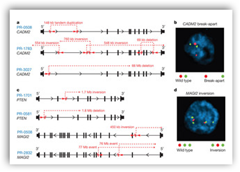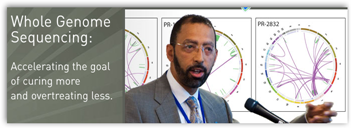We normally think about sequencing our entire genome and with this study the genome of the tumor was used to compare against white blood cells from the  patient. When you stop and think of all the data that has to be sifted through, it’s a lot. The Broad Institute, Dana-Farber Cancer Institute and Weill Cornell Medical College were the 3 locations involved in the research. All of the tumors used in the research project were from patients assessed as high risk and the ultimate goal is to determine which tumors will remain dormant or harmless and which will grow in to aggressive cancerous tumors. The Prostate Cancer Foundation in Santa Monica provided funding for the research project. BD
patient. When you stop and think of all the data that has to be sifted through, it’s a lot. The Broad Institute, Dana-Farber Cancer Institute and Weill Cornell Medical College were the 3 locations involved in the research. All of the tumors used in the research project were from patients assessed as high risk and the ultimate goal is to determine which tumors will remain dormant or harmless and which will grow in to aggressive cancerous tumors. The Prostate Cancer Foundation in Santa Monica provided funding for the research project. BD
Boston researchers have sequenced the genomes of prostate tumors from seven men, a "landmark event" that promises eventually to help clinicians learn how to differentiate between those tumors that will be highly aggressive and require immediate treatment and those that are essentially benign and that can be simply observed.
"This is a transforming moment in understanding the underlying biology of prostate cancer," said geneticist Michael F. Berger of the Broad Institute of MIT and Harvard University, lead author of the paper appearing online Wednesday in the journal Nature.
Geneticists have been sequencing a variety of tumors of different types, but the effort on prostate tumors introduces a new level of complexity. For each of the tumors, the researchers sequenced not only the genome of the tumor itself, but also the genome obtained from white blood cells of the patient so they they could identify any changes that had occurred. That produced a tremendous amount of data. If the data for each genome were presented in the form of a printed telephone book, noted Dr. Jonathan W. Simons, president and chief executive of the Prostate Cancer Foundation in Santa Monica, it would form a book 35 feet high.Each genome took less than three months to sequence and cost about $25,000, Berger said, a far cry from the years and billions of dollars that were required to sequence the first human genome a decade ago. In a best case now, he said, the analysis could be performed in two to three weeks and cost less than $20,000, and he thinks the cost could come down to less than $5,000 in a couple of years. Moreover, as researchers sequence more tumor genomes and identify what they call hotspots of genetic variation, it may not be necessary to sequence the whole genome of a patient's tumor, but only selected regions, which would reduce the cost even further.




0 comments :
Post a Comment